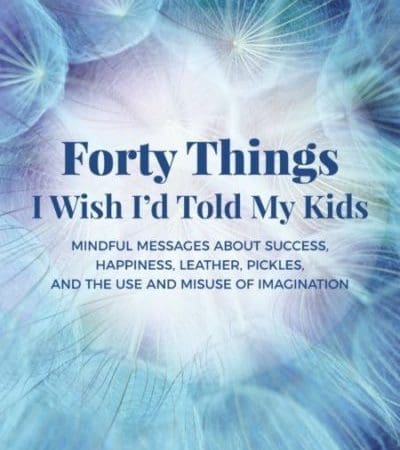II
Interview with John Allcock about Mindfulness & his new book release
In this article I will provide you with an overview of the wonderful interview I had with John Allcock about his new book of : “Forty Things I wish I would have told my kids.” Besides being an author, he does fantastic work in implementing Mindfulness Curriculum at the Sea Preparatory School in California which he co-founded.
Buy the book here:
1. Could you tell me a little more about yourself and how mindfulness lead you into writing the book?
In 2009 I was going through some challenging times and I was going through a divorce and other things, which lead me into mindfulness.
I read many books, I attended lectures and seminars and I went to (silent)retreats. It was very helpful, so I tried to find a book that I would be able to show my kids, but I could not find one yet, that could explain it clearly for children.
At one point I was in a hotel room in London I have decided to send my children emails about mindfulness. I have send around 150 emails over the years and after that, people told me that I should make this into a book, and that is exactly what happened.
2. What is the audience of your book?
Originally, I thought it would be for teens considering my kids were in their teens at the time, but after I published the book it turns out parents are a very large audience.
Most recently, I have found out that the grandparents are also a grand audience, as they have bought the book for their grandchildren.
They have explained me that they have the book on their coffee table and when their grandchildren are angry, they read that particular chapter in the book to solve the anger in the most mindfulness way possible or they use the book in any other situation and it was very helpful.
The book was initially written for people with no interest or background in Mindfulness. It isn’t until chapter 7 or 8 that real mindfulness terms are explained. I have intentionally used easy terms for everyone to understand the book and its messages.
3. Could you provide some tips for parents on how to raise kids in a mindful way?
My first chapter is about: “Do not be ruled by the tyranny of events.”
Do not let your happiness be dictated by the events that happen to you.
Realize, that our experience of life is created by the events and by your response to the events and you have always have control over your response. Your happiness is always dictated by a combination of the two, more than half is within your control.
4. Living happily takes practice is a chapter in your book, how can you commit these practices in your daily life?
Myself and the students from the Sea Preparatory School we engage in a mindful meditation 3 days a week which takes about 20 minutes each time.
We practice on how to pay attention to your breathe, examining but not getting captured by your emotions, your thoughts and the external sounds that occur outside of your own internal system. Then we realize that we can choose to engage with these factors, that it is not automatic.
5. What are the results that you see integrating mindfulness in the school system?
We see an increase of stability to pay attention, increased focus, increased compassion both for the students on how they treat each other and themselves and that is exactly what larger studies have shown with the introduction of a mindfulness curriculum.
6. “Failure leads to new things,” is explained in the book, could you explain this further?
Nothing of significance has been achieved by anybody without failing. Thomas Edison said : After spending 3 years of trying to make a light bulb, I never failed, I now know 1000 ways of how to not make a light bulb.
Learning opportunities arose where he didn’t succeed and ultimately he did succeed. What is called failure in our society is not really a failure as long as you learn something in the process.

You are not picking goals that are meaningful if you achieve something in one go. It would be like picking a goal of watching TV, but most people would not pick that as a goal.
Most probably you pick something that would require a challenge, and where there is a challenge there is a chance of failure, but also of learning.
7. What do your children think about your book?
They are very excited about the book and there was a little book launch party and they have giving it to many of their friends.
They are really devoted to the concepts that are in the book. There was a lecture series, for which they all had to suffer (laughter).
8. If you had the knowledge that you have today, would you change something in raising your kids?
Yes, for sure. I started when my youngest was in her mid-teens. I was a product of western culture, my parents and my teachers did not know about this and I went to one of the best schools in the country like Boston College and Harvard Law School.
Non of this was taught there it was not very known in the west until very recently. I would have incorporated it a lot more in raising my children if I had the knowledge.
9. Why do you think people have so many fears, as this is a subject explained in the book?
Our systems are not very different from the cave people. When we were cave people, fear was really good as there were many dangerous animals and threats which meant life or death. Self-preservation and fear and was very useful.
The problem is that we still have that same system that produces adrenaline and cortisol when we fear.
However nowadays, we just have a presentation to give or just a credit card bill to pay that we treat the same as this life and death threat of a saber tooth tiger coming near.
This constant fear really hurts our internal system. Mindfulness allows you to heal the fear and realize there is no actual tiger coming our way. The upcoming credit card bill is severe but certainly not like a saber tooth tiger coming your way.
Mindfulness can make sure that these fear thoughts will not dominate our thoughts, as most of our fears are in our imagination, as they are not real.
10. What is the message you would like to give the audience with this book
Paying attention to your present moment experience, internal and external without judgment and without being captured by that experience. It will lead to much greater happiness and success in our lives, it is definitely worth it to study and to practice it daily.
Mindfulness can be done everywhere, because all you need is your awareness. You have your awareness all the time and another practical tool is to use your breath.
The two of those together are a perfect exercise for mindfulness. In whenever situation you are and some emotions are dominating, you could practice these things. It is a perfect situation to create space and in that space you can choose your freedom.
11. Do you think that adding a mindfulness curriculum would solve lot of problems in the world? And are you thinking about expanding it to other schools?
A lot of studies have shown that it improves the overall well-being of the students. It improves their results and it makes them more self-aware. Right now I am working on a curriculum that can be used in other schools. It will consist of three or four meditations a week and of a common talk with the class.
Many of the subjects that are covered in the book are discussed in class at school. It is amazing how fourth-graders can take these things easier almost than adults.
12. Could you give me one sentence that would inspire people to do mindfulness?
Mindfulness provides you to opportunity to choose your intention in each moment, and in that choice lies your freedom.
Thank you so much for this interview. I wish you great luck with the book and spreading the mindfulness in the world by your school curriculum.

